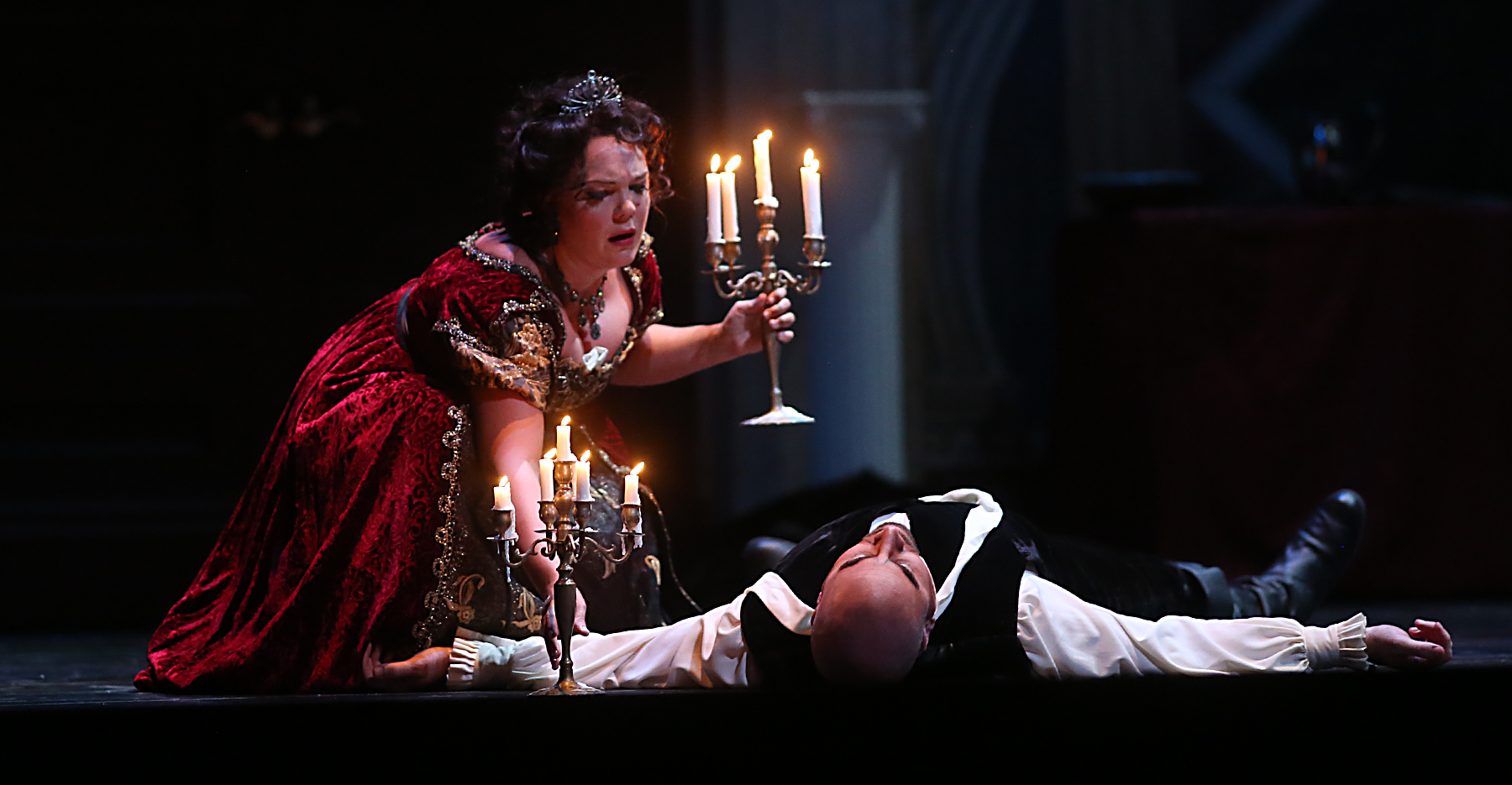Grand opera delights in the ‘bigger is better’ motto. However, often it is the attention to detail that really makes the work transcendent. Lyric Opera Baltimore‘s opening night of Puccini’s Tosca was a fascinating display of counterparts that all come together to create a taut stage production offering opportunities for Cavaradossi, Tosca, and Scarpia to shine. The keen eye and love of the art form that bursts forth from Director James Harp is clearly evident in this production.
Puccini did not write a prelude for Tosca. Three portentous opening bars introduce the Scarpia motif and the Baltimore Symphony Orchestra brass brought all of their explosive power to bear then and each time the motif was recalled always eliciting a bone-chilling effect. Puccini wrote Tosca as an opera of action. The pace is swifter and relies on smart, shorter motives throughout. Therefore, any performance of Tosca lives by the push-and-pull of the action. Jill Gardner, as the ill-fated Tosca, made full use of her force/counter-force proficiency whether loving and flirtatious with Dinyar Vania as Cavaradossi or terrified and vengeful with Raymond Aceto as Scarpia. In fact, during the Act I Tosca and Cavaradossi love duet “Non la sospri la nostra casetta” the playful back and forth between the two provoked abundant laughter from the audience especially at “Ma falle gli occhi neri!“

Gardner and Aceto’s stage presence was wholly opposite and in itself another counterweight to the sweet, humourous, and dedicated lovers. Aceto plays his Scarpia as the ultimate snake in the grass knowing exactly how to bait the jealous Tosca — “Quanto promessa nel tuo pronto sospetto!” (How much promise there is in your ready suspicion.) Aceto was able to change his vocal tone color to appropriately convey the differences between seeking Tosca’s affections and his blatant willingness to brutally violate her. Aceto, bathed in a sinister red spotlight at the end of Act I, sang “Tosca, mi fai dimenticare Iddio!” with terrifying intensity. The climactic moments at the end of Act II between Gardner and Aceto, however, were certainly moving but left something to be desired. While Gardner displayed a lovely warmth and enveloping sound in earlier scenes, she seemed to choose a much more defiant and straightforward approach to the illustrious “Vissi d’arte.” It had the impression of too much emotion in the voice while the “Mi vuoi supplice ai tuoi piedi!” that followed the aria was much more effective and not as overwrought.
François Loup as the Sacristan was such an inspired choice for Lyric Opera Baltimore given his ability to engage an audience from the very first movement he makes on stage (a sneeze under a blanket at that.) What M. Loup seems to instinctively understand is that every moment on stage is a choice. One does not need to make grand aimless gestures to be part of a grand opera. For all of Vania’s eagerness in the first scene, there was Loup to balance the actions and make it seem more believable. David Sadlier as Spoletta, Phillip Collister as the Jailer, and John Moses as the Shepherd Boy also added life and skilled singing to the production.
Steven White did not let the brass get away with having all the fun with Puccini’s score. He absolutely caressed some of the finely played lines from the woodwinds and strings – showing some real pathos in Act III. Finally the Lyric Opera Baltimore Chorus joined by the Maryland State Boychoir was incapable of being subdued in their fantastic “Te Deum” which was something of a feast for almost all of the senses with the incense from four thuribles spreading throughout the gorgeous set. Surely, it makes one look forward to hearing them in Verdi’s “Va, pensiero” in their spring production of Nabucco.
When it comes to Lyric Opera Baltimore, their vision of grand opera is not simply that bigger is better but that better is better. They are certainly an institution of which Baltimore should be exceedingly proud. Tosca is an opera of happenings and Lyric Opera Baltimore delivered a passionate and enthralling performance.

[…] Dinyar Vania as the Duke of Mantua was a true vacillating character between the contrast of inwardly noble Rigoletto and Gilda and the grotesque Sparafucile and Maddalena perhaps being even more fickle than his famous aria “La donna è mobile” suggests of women. Vania’s most vocally compelling moments were the beginning of Act II with “Parmi veder le lagrime.” Audrey Babcock‘s Maddalena was every bit the bad girl with a luscious voice to match which never lost its presence in the third act quartet. Her seductive foil to Gilda’s purity made the second act sparkle with tension. Finally, the barbarous Sparafucile as performed by Burak Bilgili bristled with a truly ominous low F in suit with his sinister look. Heath Huberg as Borsa, Adam Cannedy as Marullo, Tyler Putnam as Count Ceprano, and Amanda DeBoer as Countess Ceprano also added vitality, forward momentum, and skilled singing to the production. […]